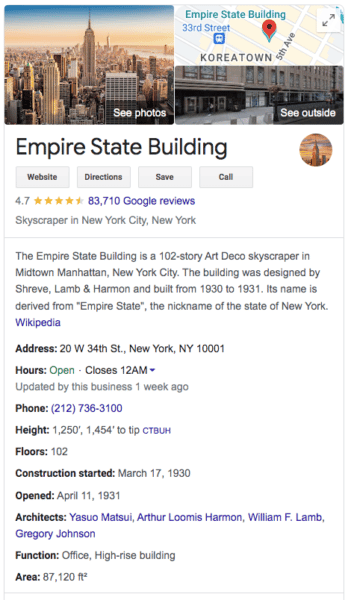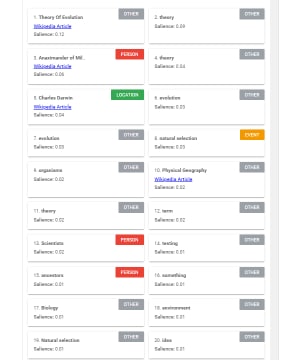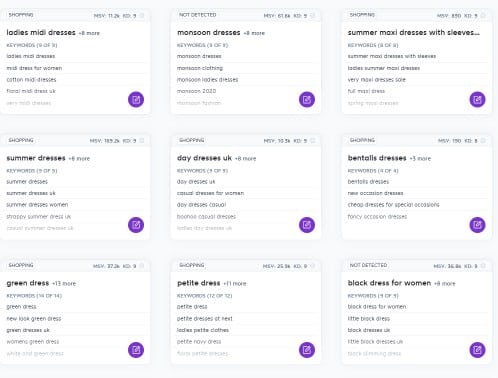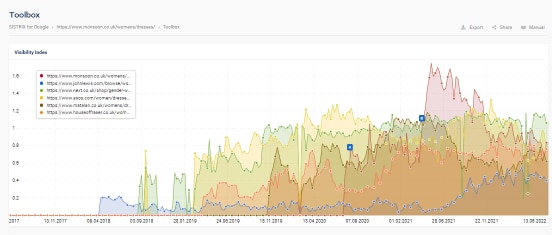As search engines evolve to understand language in a more sophisticated way, relationships are becoming ever more important in SEO. Semantic search is here to stay so it’s time to pay attention to connections and associations to take your SEO content to a new level.
Using entities in your content can help you produce higher-quality pieces.
Linking these pages, guides and sections of your website together can help to maximize relationships even further to achieve some outstanding results.
So how can you get started?
Terminologies you’ll need to know
- Natural Language Processing (NLP): The process of understanding text and speech words like a human being does. It’s a branch of AI computer science that helps machines to interpret and understand the true meaning behind words. Google uses NLP to better understand our search queries and to serve the best results to those queries.
- Entities: Google defines an entity as a thing or concept that is “singular, unique, well-defined, and distinguishable.” These entities are identified and labeled, helping search engines to understand their meaning based on their relationship with other entities.
- Semantic search: The process of providing a user with the best possible results to their query based on the true meaning of that query. The search engine uses language and entity relationships to understand search intent, and the context of that query and serve up results grounded in actual meaning rather than keyword matching.
How are all these connected?
NLP and the understanding of entities are the keys to making semantic search work successfully.
If Google didn’t have a good grasp of how we really use and understand language, it could easily misinterpret certain search queries.
Equally, incorrect labeling of what an entity is could produce some confusing search results.
As humans, we make these connections naturally due to the context in which we experience them. AI has to learn these connections based on contextual cues.
Over recent years, Google’s Hummingbird, BERT and now MUM updates have all been building toward a more sophisticated semantic search. (You can find out more about Google’s use of AI in search here.)
With all this in mind, it’s time to delve into the multiple facets of leveraging relationships to get better SEO results.
1. Content
Writing great content for semantic search goes way beyond simple keywords. It must contain the relevant entities and consider the relationships between them.
Why do entities matter in SEO content?
Entities are important for SEO content because they are connected by relationships. These entities and the relationships that associate them are what Google is using to determine meaning and context within any piece of written content.
All these things and concepts are related to other things and concepts.
Some of these relationships are very strong, others are weaker.
Some entities are widely used in text across the web in lots of different contexts, and others are used sparingly in specific circumstances.
These entities are understood by Google’s knowledge graph.
For a well-recognized entity like the Empire State Building, you can see a really rich knowledge graph panel that includes basic information, address, opening hours, busy times, reviews and even recent news.

This could help to answer a whole host of users’ queries before they have even asked them.
Semantic search learns from all these connections to determine the information that’s going to be most relevant to a user’s query.
So, why should this matter for SEO?
If you want Google to serve your content as one of the top results for a certain set of queries, it’s crucial to include the entities with the strongest relationships to those queries.
This requires a thorough understanding of a topic and the entity relationships involved.
How can I use relationships to write better SEO content?
When we appreciate how important entities are in search, it’s easy to see why considering which entities relate to the topics we’re writing about is vital for serving users’ queries.
If you want to write better content, you need to thoroughly explore the entities and relationships involved.
If you were writing about the theory of evolution, for example, your content would be lacking if it didn’t mention Charles Darwin, natural selection, humans, history, and ancestors.
In fact, you can see a lot of these entities connected to the topic using Google’s image search:

This is a fairly simplistic example to illustrate the idea, and writing great content is much more nuanced. There are likely to be thousands of different words, phrases and entities that will have relationships to your overall topic.
It’s important to look for phrases that often co-occur with your main topic alongside your partial match terms. This helps to set the context for your content using Phrase-Based Indexing. These related phrases aren’t found using classic keyword research methods.
So here’s how you can find the information you need to start creating NLP-friendly content.
How do I find related entities and NLP keywords for my content?
There are a variety of tools that can help with this such as:
- InLinks
- SurferSEO
- Frase
- Semrush
- Scalenut
- Ryte
These tools are really simple to use. All you have to do is set up an editor or project using your keyword of choice (or a selection of closely related keywords).
The tools do lots of the heavy lifting, providing you with a list of terms, phrases or entities to include in your copy. Some even guide you on how frequently you should use them.
You can use these guidelines to write your content, using any of the related terms that you can naturally weave in. Often, the NLP terms are arranged by impact too, so you can give more prominence to those at the top of the list.
You can also review text that already ranks well for a topic using the Google NLP tool. Check the ‘entities’ tab to find salient entities on a topic:

This can help you to pick out any entities you might have missed. You can use this same process to review the salience of certain entities within your own content once you have written it.
The good news is, that semantic search is aiming to understand human search intent and serve relevant results.
The approach is conversational, so your most powerful tool is your humanity.
Research your topic well, write to serve real people and you should naturally include many of the relevant entities and their relationships.
2. Pillar pages and topic clusters
Getting each individual piece of content right is only one part of the puzzle.
The next challenge for a content strategist or SEO is to consider and maximize relationships between different topics and content.
Just like each term and entity, each piece of content covers a topic that is related to other topics. These relationships can be powerful or insubstantial.
What is a topic cluster strategy?
A topic cluster strategy maximizes contextual relationships between pages and pieces of content by clustering them together to add to their strength. It involves a series of supporting pages that look at areas in-depth, linking to a piece of pillar content that broadly covers the central topic.
Topic clusters improve the user journey because they make it easier for people to find related information. They provide rich and relevant resources and package them based on their relationships with one another.
How can I find topic clusters?
While it’s easy to find related topics and questions on a subject using tools like AnswerThePublic and AlsoAsked, one of the biggest challenges is how to structure these questions.
Where does an article end and another begin? What forms a relevant part of a topic cluster and what stands alone?
Start by grouping similar questions together and you can quickly form the basis of an article. Arranging queries, prepositions and other long-tail search terms together by common themes will give you a series of different content ideas to form part of a larger cluster.
The most defined topic clusters should become apparent through critical thinking. Once you’ve created a list of article ideas, you need to consider the relationships between them.
There are some distinct content cluster types, such as:
- Step-by-step guides: A guide that’s simply too long to be one article, such as a guide to technical SEO, could be split into multiple, detailed parts to create a content cluster. This would create a linear relationship between part 1, part 2 etc.
- Monthly calendars: Each monthly entry would form part of the topic cluster. This would also look quite linear, and users will move from one part to the next.
- A themed set: A group of things with a shared essence that works well together. For example, a set of recipes that all include a specific ingredient or a group of case studies covering a certain industry. The relationships between these may be more complex, but they still form a valid set.
All these show clear relationships that would form a really strong cluster. They would also benefit from an overarching pillar page to house them all and tie the broad topic together.
If you have topic cluster ideas but the relationships between them are not immediately clear, create a map of how they link together. If you’re finding it hard to create a relationship between one topic and another, it probably isn’t right for your cluster. Any orphan content should be removed or considered as part of a different topic cluster.
These relationships will become your internal linking strategy. Contextual links are used by Google as a frame of reference, so it’s important to use relevant anchor text when linking to other parts of your topic cluster.
Why are pillar pages so powerful?
Pillar pages are really powerful because they show depth and breadth of knowledge about a certain subject. If you execute them well, they help to demonstrate your expertise because you are consistently publishing high-quality content on a topic and demonstrating that you understand the relationships between these topics.
Here’s an authoritative pillar page on Search Engine Land, that combines a whole host of related articles, relevant questions and entities to create a leading resource on the broad keyword SEO. It’s much more effective than a one-page article about SEO because it helps to signpost readers to other related topics and helps to answer the next question they might have rather than sending them back to search again.
3. Website
Ideally, your pillar pages will cover all the broad topics that are important to your website as a whole. Getting this right can feel really daunting.
So where do you start?
What content should I post on my website?
If you’re starting from scratch and wondering what content to post on your website, try starting from the top down. Ask yourself what the broadest level of what your website represents is.
Next, consider all the high-level topics you intend to cover. You might already have this structure in place via your website navigation, depending on what type of site you work on, and what stage of development you’re in.
- For ecommerce sites, research all the things people want to know about your main product categories.
- For service-based or corporate websites, consider thoroughly answering questions about your core service areas and industry.
- For publishing sites, consider the main topics you’ll be covering and create a detailed hub and spoke plan to cover these in-depth.
If you want to harness relationships to improve SEO, it’s really important to keep things relevant. Don’t stray too far from your core topics and make sure every page relates to other pages on your site.
How do you become an authority on a topic?
Maximize relationships, and do it well. To become a true authority, you need to regularly post high-quality content related to your main topic and interlink the related pieces of content. When you start to rank well for whole clusters of related keywords, it becomes easier to rank for related topics.
If you do this often enough, and well enough, you could be creating semantic links of your own. What we write is feeding machine learning, so if your brand is consistently linked with certain phrases you will be strengthening the semantic links between your own brand and these phrases yourself.
This could be the case for unlinked mentions too if an authoritative site is talking about you in the right context.
A real-life example
I decided to use a keyword clustering tool to find a real example of a brand that has strong semantic links to a topic.
In the UK if I search for ‘women’s dresses’ in the keyword clustering tool I can find many clusters covering dress types, but also some branded keyword clusters, like ‘Monsoon dresses’. This shows us that the brand ‘Monsoon’ already has quite a strong semantic connection to the term ‘women’s dresses’.

And while Monsoon themselves don’t rank on Page 1 for ‘women’s dresses’, their dresses section has reached visibility heights across a whole range of keywords that their competitors have not.

Monsoon has created a diverse range of pages to capitalize on a wide collection of related searches, amplifying their reach by considering the relationship between their pages rather than just focusing on one page ranking for the broad term.
Quality + relevance + context
A semantic strategy covers all the overarching principles of SEO content.
Writing effective SEO content is really all about recognizing relationships between words, topics and pages – but when you’re working at a granular level that’s easy to forget.
A powerful strategy gets the best out of these relationships to produce results, no matter what industry you’re in.
The post How to use relationships to level up your SEO appeared first on Search Engine Land.


